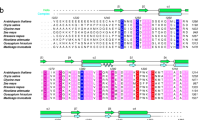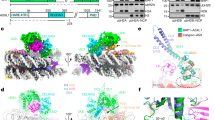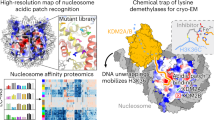Abstract
The tandem PHD finger–bromodomain, found in many chromatin-associated proteins, has an important role in gene silencing by the human co-repressor KRAB-associated protein 1 (KAP1). Here we report the three-dimensional solution structure of the tandem PHD finger–bromodomain of KAP1. The structure reveals a distinct scaffold unifying the two protein modules, in which the first helix, αZ, of an atypical bromodomain forms the central hydrophobic core that anchors the other three helices of the bromodomain on one side and the zinc binding PHD finger on the other. A comprehensive mutation-based structure-function analysis correlating transcriptional repression, ubiquitin-conjugating enzyme 9 (UBC9) binding and SUMOylation shows that the PHD finger and the bromodomain of KAP1 cooperate as one functional unit to facilitate lysine SUMOylation, which is required for KAP1 co-repressor activity in gene silencing. These results demonstrate a previously unknown unified function for the tandem PHD finger–bromodomain as an intramolecular small ubiquitin-like modifier (SUMO) E3 ligase for transcriptional silencing.
This is a preview of subscription content, access via your institution
Access options
Subscribe to this journal
Receive 12 print issues and online access
$189.00 per year
only $15.75 per issue
Buy this article
- Purchase on Springer Link
- Instant access to full article PDF
Prices may be subject to local taxes which are calculated during checkout




Similar content being viewed by others
References
Fischle, W., Wang, Y. & Allis, C.D. Histone and chromatin cross-talk. Curr. Opin. Cell Biol. 15, 172–183 (2003).
Kouzarides, T. Chromatin modifications and their function. Cell 128, 693–705 (2007).
Li, B., Carey, M. & Workman, J.L. The role of chromatin during transcription. Cell 128, 707–719 (2007).
Jenuwein, T. & Allis, C.D. Translating the histone code. Science 293, 1074–1080 (2001).
Strahl, B.D. & Allis, C.D. The language of covalent histone modifications. Nature 403, 41–45 (2000).
Turner, B.M. Cellular memory and the histone code. Cell 111, 285–291 (2002).
Berger, J. & Bird, A. Role of MBD2 in gene regulation and tumorigenesis. Biochem. Soc. Trans. 33, 1537–1540 (2005).
Dhalluin, C. et al. Structure and ligand of a histone acetyltransferase bromodomain. Nature 399, 491–496 (1999).
Jacobson, R.H., Ladurner, A.G., King, D.S. & Tjian, R. Structure and function of a human TAFII250 double bromodomain module. Science 288, 1422–1425 (2000).
Mujtaba, S., Zeng, L. & Zhou, M.M. Structure and acetyl-lysine recognition of the bromodomain. Oncogene 26, 5521–5527 (2007).
Bannister, A.J. et al. Selective recognition of methylated lysine 9 on histone H3 by the HP1 chromo domain. Nature 410, 120–124 (2001).
Lachner, M., O'Carroll, D., Rea, S., Mechtler, K. & Jenuwein, T. Methylation of histone H3 lysine 9 creates a binding site for HP1 proteins. Nature 410, 116–120 (2001).
Khorasanizadeh, S. The nucleosome: from genomic organization to genomic regulation. Cell 116, 259–272 (2004).
Li, H. et al. Molecular basis for site-specific read-out of histone H3K4me3 by the BPTF PHD finger of NURF. Nature 442, 1058–1061 (2006).
Peña, P.V. et al. Molecular mechanism of histone H3K4me3 recognition by plant homeodomain of ING2. Nature 442, 100–103 (2006).
Taverna, S.D., Li, H., Ruthenburg, A.J., Allis, C.D. & Patel, D.J. How chromatin-binding modules interpret histone modifications: lessons from professional pocket pickers. Nat. Struct. Mol. Biol. 14, 1025–1040 (2007).
Lan, F. et al. Recognition of unmethylated histone H3 lysine 4 links BHC80 to LSD1-mediated gene repression. Nature 448, 718–722 (2007).
Matthews, A.G. et al. RAG2 PHD finger couples histone H3 lysine 4 trimethylation with V(D)J recombination. Nature 450, 1106–1111 (2007).
Ramón-Maiques, S. et al. The plant homeodomain finger of RAG2 recognizes histone H3 methylated at both lysine-4 and arginine-2. Proc. Natl. Acad. Sci. USA 104, 18993–18998 (2007).
Dey, A., Chitsaz, F., Abbasi, A., Misteli, T. & Ozato, K. The double bromodomain protein Brd4 binds to acetylated chromatin during interphase and mitosis. Proc. Natl. Acad. Sci. USA 100, 8758–8763 (2003).
Kanno, T. et al. Selective recognition of acetylated histones by bromodomain proteins visualized in living cells. Mol. Cell 13, 33–43 (2004).
Vandemark, A.P. et al. Autoregulation of the rsc4 tandem bromodomain by gcn5 acetylation. Mol. Cell 27, 817–828 (2007).
Flanagan, J.F. et al. Double chromodomains cooperate to recognize the methylated histone H3 tail. Nature 438, 1181–1185 (2005).
Huang, Y., Fang, J., Bedford, M.T., Zhang, Y. & Xu, R.M. Recognition of histone H3 lysine-4 methylation by the double tudor domain of JMJD2A. Science 312, 748–751 (2006).
Yap, K.L. & Zhou, M.M. Structure and function of protein modules in chromatin biology. Results Probl. Cell Differ. 41, 1–23 (2006).
Ruthenburg, A.J., Li, H., Patel, D.J. & Allis, C.D. Multivalent engagement of chromatin modifications by linked binding modules. Nat. Rev. Mol. Cell Biol. 8, 983–994 (2007).
Ragvin, A. et al. Nucleosome binding by the bromodomain and PHD finger of the transcriptional cofactor p300. J. Mol. Biol. 337, 773–788 (2004).
Dou, Y. et al. Physical association and coordinate function of the H3 K4 methyltransferase MLL1 and the H4 K16 acetyltransferase MOF. Cell 121, 873–885 (2005).
Kitagawa, H. et al. The chromatin-remodeling complex WINAC targets a nuclear receptor to promoters and is impaired in Williams syndrome. Cell 113, 905–917 (2003).
Venturini, L. et al. TIF1gamma, a novel member of the transcriptional intermediary factor 1 family. Oncogene 18, 1209–1217 (1999).
Bloch, D.B., de la Monte, S.M., Guigaouri, P., Filippov, A. & Bloch, K.D. Identification and characterization of a leukocyte-specific component of the nuclear body. J. Biol. Chem. 271, 29198–29204 (1996).
Capili, A.D., Schultz, D.C., Rauscher, F.J. III & Borden, K.L. Solution structure of the PHD domain from the KAP-1 corepressor: structural determinants for PHD, RING and LIM zinc-binding domains. EMBO J. 20, 165–177 (2001).
Ivanov, A.V. et al. PHD Domain-mediated E3 ligase activity directs intramolecular sumoylation of an adjacent bromodomain required for gene silencing. Mol. Cell 28, 823–837 (2007).
Abrink, M. et al. Conserved interaction between distinct Kruppel-associated box domains and the transcriptional intermediary factor 1 β. Proc. Natl. Acad. Sci. USA 98, 1422–1426 (2001).
Friedman, J.R. et al. KAP-1, a novel corepressor for the highly conserved KRAB repression domain. Genes Dev. 10, 2067–2078 (1996).
Le Douarin, B. et al. A possible involvement of TIF1 alpha and TIF1 beta in the epigenetic control of transcription by nuclear receptors. EMBO J. 15, 6701–6715 (1996).
Clore, G.M. & Gronenborn, A.M. Multidimensional heteronuclear nuclear magnetic resonance of proteins. Methods Enzymol. 239, 349–363 (1994).
Gozani, O. et al. The PHD finger of the chromatin-associated protein ING2 functions as a nuclear phosphoinositide receptor. Cell 114, 99–111 (2003).
Capili, A.D. & Lima, C.D. Taking it step by step: mechanistic insights from structural studies of ubiquitin/ubiquitin-like protein modification pathways. Curr. Opin. Struct. Biol. 17, 726–735 (2007).
Geiss-Friedlander, R. & Melchior, F. Concepts in sumoylation: a decade on. Nat. Rev. Mol. Cell Biol. 8, 947–956 (2007).
Mascle, X.H., Germain-Desprez, D., Huynh, P., Estephan, P. & Aubry, M. Sumoylation of the transcriptional intermediary factor 1β (TIF1β), the co-repressor of the KRAB multifinger proteins, is required for its transcriptional activity and is modulated by the KRAB domain. J. Biol. Chem. 282, 10190–10202 (2007).
Li, X. et al. Role for KAP1 serine 824 phosphorylation and SUMOylation/deSUMOylation switch in regulating KAP1-mediated transcriptional repression. J. Biol. Chem. 282, 36177–36189 (2007).
Ziv, Y. et al. Chromatin relaxation in response to DNA double-strand breaks is modulated by a novel ATM- and KAP-1 dependent pathway. Nat. Cell Biol. 8, 870–876 (2006).
Lin, D.Y. et al. Role of SUMO-interacting motif in Daxx SUMO modification, subnuclear localization, and repression of sumoylated transcription factors. Mol. Cell 24, 341–354 (2006).
Yurchenko, V., Xue, Z. & Sadofsky, M.J. SUMO modification of human XRCC4 regulates its localization and function in DNA double-strand break repair. Mol. Cell. Biol. 26, 1786–1794 (2006).
Klenova, E., Chernukhin, I., Inoue, T., Shamsuddin, S. & Norton, J. Immunoprecipitation techniques for the analysis of transcription factor complexes. Methods 26, 254–259 (2002).
Wang, C. et al. MDM2 interaction with nuclear corepressor KAP1 contributes to p53 inactivation. EMBO J. 24, 3279–3290 (2005).
Brunger, A.T. et al. Crystallography & NMR system: A new software suite for macromolecular structure determination. Acta Crystallogr. D Biol. Crystallogr. 54, 905–921 (1998).
Nilges, M. & O'Donoghue, S. Ambiguous NOEs and automated NOE assignment. Prog. Nucl. Magn. Reson. Spectrosc. 32, 107–139 (1998).
Laskowski, R.A., Rullmannn, J.A., MacArthur, M.W., Kaptein, R. & Thornton, J.M. AQUA and PROCHECK-NMR: programs for checking the quality of protein structures solved by NMR. J. Biomol. NMR 8, 477–486 (1996).
Acknowledgements
We wish to acknowledge the use of the NMR facilities at the New York Structural Biology Center for this study. K.L.Y. was supported by a Terry Fox Foundation postdoctoral fellowship from the National Cancer Institute of Canada. F.J.R. was supported by grants from the US National Institutes of Health (CA095561 and CA092088), The Samuel Waxman Cancer Research Foundation, The Pardee Foundation and The Commonwealth Universal Research Enhancement Program, Pennsylvania Department of Health. M.-M.Z. was in part supported by funds from the Dr. Golden and Harold Lamport Chair, and grants from the US National Institutes of Health (CA087658) and the US National Science Foundation (#0517352).
Author information
Authors and Affiliations
Contributions
L.Z. determined the protein structure by NMR, K.L.Y. characterized the protein structure-function by NMR; A.V.I. performed in vitro SUMOylation and transcription repression studies; X.W., S.M., and O.P. contributed to molecular cloning, protein purification and characterization of the study. The project was directed by M.-M.Z. and F.J.R. All authors contributed to the preparation of the manuscript.
Corresponding author
Supplementary information
Supplementary Text and Figures
Supplementary Figures 1–5 (PDF 5082 kb)
Rights and permissions
About this article
Cite this article
Zeng, L., Yap, K., Ivanov, A. et al. Structural insights into human KAP1 PHD finger–bromodomain and its role in gene silencing. Nat Struct Mol Biol 15, 626–633 (2008). https://doi.org/10.1038/nsmb.1416
Received:
Accepted:
Published:
Issue Date:
DOI: https://doi.org/10.1038/nsmb.1416
This article is cited by
-
Bromodomain and extraterminal (BET) proteins: biological functions, diseases, and targeted therapy
Signal Transduction and Targeted Therapy (2023)
-
Trim28 citrullination maintains mouse embryonic stem cell pluripotency via regulating Nanog and Klf4 transcription
Science China Life Sciences (2023)
-
RIPK3 activation induces TRIM28 derepression in cancer cells and enhances the anti-tumor microenvironment
Molecular Cancer (2021)
-
TRIM28 SUMOylates and stabilizes NLRP3 to facilitate inflammasome activation
Nature Communications (2021)
-
The PHD finger of Arabidopsis SIZ1 recognizes trimethylated histone H3K4 mediating SIZ1 function and abiotic stress response
Communications Biology (2020)



